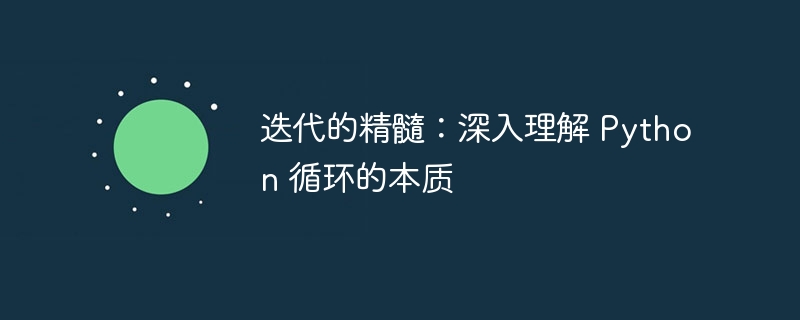
理解迴圈的本質
#循環是一種控制流程機制,可讓您根據特定條件重複執行程式碼區塊。 python 提供了兩種主要的迴圈類型:for 迴圈和 while 迴圈。
for 迴圈:用於遍歷序列,例如清單或元組。它從序列開頭開始,並逐一遍歷每個元素,直到到達末尾。
while 迴圈:用於重複執行程式碼區塊,直到滿足特定條件為止。它不斷評估條件表達式,並在條件為 True 時執行程式碼區塊。
for 迴圈
for 迴圈的語法如下:
for item in sequence: # 代码块
其中:
item 是循環中的局部變量,用於儲存序列的當前元素。 sequence 是您要遍歷的序列。 示範程式碼:
colors = ["red", "blue", "green"]
for color in colors:
print(f"The color is {color}")
# 输出:
# The color is red
# The color is blue
# The color is greenwhile 迴圈
#while 迴圈的語法如下:
while condition: # 代码块
其中:
condition 是一個布林表達式,用來決定是否重複執行程式碼區塊。 示範程式碼:
count = 1
while count <= 10:
print(f"Current count: {count}")
count += 1
# 输出:
# Current count: 1
# Current count: 2
# ...
# Current count: 10進階用法
除了基本用法外,Python 迴圈還有以下進階用法:
break 語句:用於立即退出迴圈。 continue 語句:用於跳過目前迭代並繼續下一個迭代。 迭代器的作用
#迭代器在 Python 循環中扮演至關重要的角色。迭代器是一個對象,它可以在其元素上提供一個可遍歷的介面。當您使用 for 迴圈時,底層會自動呼叫迭代器方法來取得序列的元素。
示範程式碼:
class MyRange: def __init__(self, start, end): self.start = start self.end = end def __iter__(self): current = self.start while current < self.end: yield current current += 1 for number in MyRange(1, 10): print(number) # 输出: # 1 # 2 # ... # 9
結論
Python 迴圈是強大的工具,用於控製程式流程和處理資料。透過理解 for 迴圈和 while 迴圈的本質,並利用進階用法和迭代器,您可以編寫高效且可維護的程式碼。掌握 Python 循環的精髓,將顯著提升您的程式技能。
以上是迭代的精髓:深入理解 Python 循環的本質的詳細內容。更多資訊請關注PHP中文網其他相關文章!




